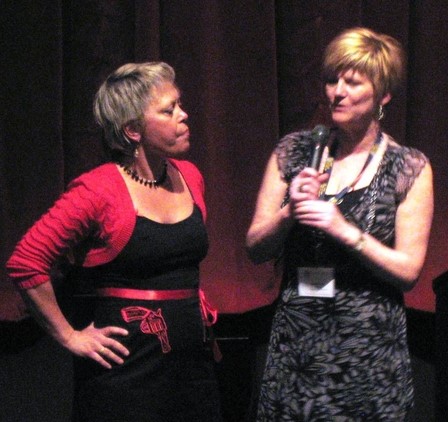The Penelope Buitenhuis’s Way
Technology is changing filmmaking techniques. Meanwhile, Penelope Buitenhuis’s work might be a trend toward more focus on the message and less on the form.
After the screening of her film A Wake—at the 2010 Vancouver Women in Film Festival (VWIFF)— Roslyn Muir asks Buitenhuis questions about the shooting as I glance at the pistols embroidered on her pockets.
The Way to a Career in Filmmaking
Buitenhuis studied film history at UBC (University of British Columbia) and made her first experimental films in Paris. She later attended SFU (Simon Fraser University) film program and completed four shorts. She spent the following ten years in Paris and Berlin, making underground films in super 8-16 mm, a respected art form in Europe. The screening of her documentary on the Berlin Wall (Llaw), at the Berlin Film Festival, got noticed by German television and led to her first commissioned commercial feature.
Since then, she has been a prolific and sometimes controversial writer and director of documentaries, features, and series. She still makes short films in-between projects because “with digital media, you can make your films cheaply.” In an interview with the Vancouver Sun, Buitenhuis’s advice to aspiring filmmakers is to make shorts to gain experience and credibility, and before applying for film financing. A no-nonsense character in her own life, the industry knows her for what she preaches. She is fast, and she is thrifty.
A Wake Short Synopsis
A Wake follows the death of a theater director (Nicholas Campbell). His (secret) wish was to have the estranged members of his last and ill-fated production of Hamlet meet again. When the director’s son (Kristopher Turner) insists that they tell the truth, each member’s confession wildly rocks the emotions of the group. The widow (Tara Nicodemo) suggests that the evening be filmed as a tribute to her late husband. A camera in the powder room records intimate monologues with the defunct. When morning comes, foggy minds leave the country-estate, yet the wake is no wrap.
How to Shoot a Movie in Ten Days
Buitenhuis explains that her Telefilm-funded feature was shot in one location in ten days and edited on an avid for four months. It was filmed in HD on a Sony 900 with two cameras at once.
The script was limited to four lines to let intuition flow through the impromptu exchanges. “Regular scripts pull away from life and therefore from the truth,” she says. Truth is important to Penelope Buitenhuis, whose father passed away shortly before she started filming. “Only the truth remains,” she adds.
Buitenhuis prefers to spend time talking with the actors about their characters rather than imposing the control of a linear script. The Gemini-award winner for Tokyo Girls and Leo-nominated director of Dangerous Attractions likes short-time shoots—so the actors and their emotional momentum don’t have time to wind down. Instead, she filmed A Wake with eight to ten takes per scene.
The central dinner scene was rehearsed for two days. But the rape disclosure was impromptu to let the actor (Sarain Boylan) travel through her spectrum of emotions. A similar approach was used for the scenes in the powder room. All were improvised, to the anecdotal point that one actor dug so deep into his emotions, he forgot he was in character.
The casting included multi-tasking. The actor who played the neighbor (Paul Braunstein) also did the reading for auditions. Buitenhuis likes to recall that Danielle (Sarain Boylan), the wildest among the film characters, was hard to handle at times but was the right casting for the unrestrained hysterical scenes she created.
First Published 2010 Suite101.com

(MCArnott)
